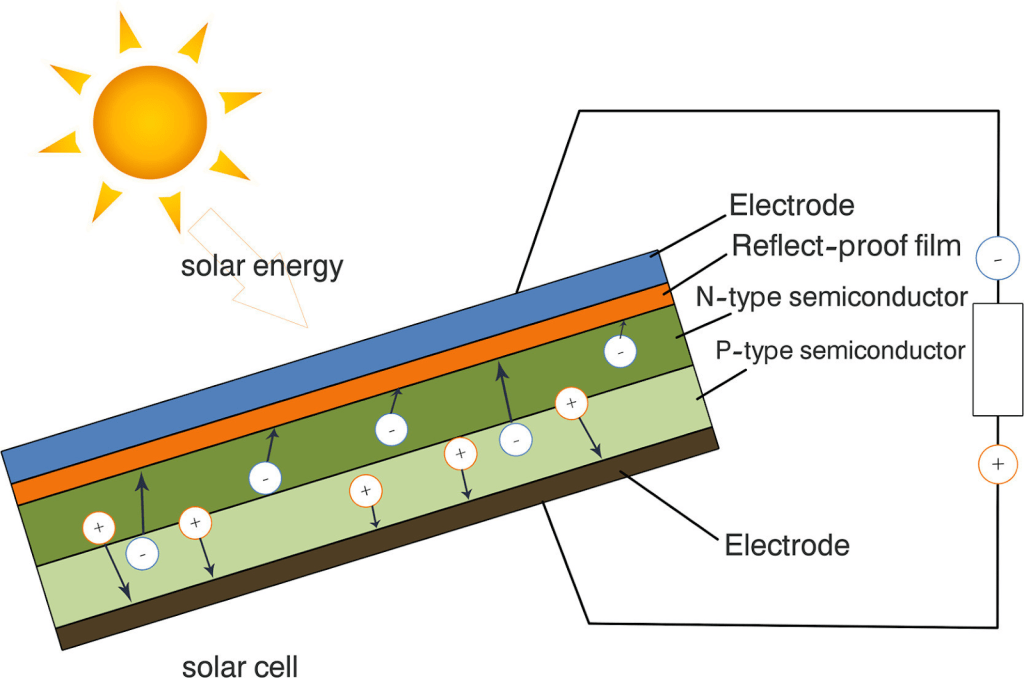Steady progress in renewable energy is opening up new opportunities for the efficient use of energy sources (B. Parida et al., 2011). The Intergovernmental Panel on Climate Change (IPCC) is calling for efficient energy conservation to combat global warming and climate change (Guterres, 2022). Alternative “green” energy is on the rise everywhere across the world. The share of the market dedicated to solar power specifically is also growing rapidly in many countries. Many, including THRIVE, have called photovoltaic solar the way of the future. Specifically, transparent solar cells may hold the key.

Source: SOLAR MAGAZINE
Solar energy is the most abundant energy resource on earth — 173,000 terawatts of solar energy strikes the Earth continuously. That’s more than 10,000 times the world’s total energy use. The building sector accounts for around 40% of total energy consumption in developed countries (Yujie Ke, 2018), and the heating, ventilation, and air conditioning (HVAC) systems in those buildings consume around half of that energy (Yujie Ke, 2018; L. Perez-Lombard et al., 2008).
Transparent Solar Cells in Windows?
Windows are the least energy-efficient part of a building, because they are thermal holes. As a result, various energy-saving windows have been developed. Most focus on spectrally selective optical coatings, (T. Rosencrantz et al., 2005) chromogenic coatings based on electrochromic, photochromic, and thermochromic phenomena, and integration of near-ultraviolet (UV) solar cells with electrochromic windows (N. C. Davy, 2017). These windows enable control of luminous and near-infrared (NIR) light transmission and regulation of the solar heating effect (Y. Wang, 2016).
Although they relieve the burden of indoor cooling and reduce building energy consumption, these windows inevitably dissipate a large portion of solar energy in the UV and NIR bands into waste heat. This is particularly the case in hot seasons, and it degrades building energy efficiency and intensifies the urban heat island effect. We need windows that can harvest the dissipated solar energy either in the form of electricity or thermal energy (Weihong Li et al., 2022). Transparent solar cells may help us achieve this.
What is a Solar Cell?
Solar cells are also known as photovoltaic (PV) cells. Solar cells are electronic components of the solar system that generate electricity when exposed to photons, aka sunlight. The manufacture of solar cells uses single crystals and polycrystals. In most cases, these cells have multiple layers with two semiconductors in between. Of these two semiconductors, one is mounted at the top and the other at the bottom. The upper semiconductor has extra electrons that generate a negative charge. However, the lower semiconductor has no electrons and is a positive electrode layer. When sunlight hits the upper semiconductor, loose electrons are emitted to the lower cathode layer. Since semiconductors allow electrons to enter cells, there is a barrier between the positive and negative plates. Therefore, when loose electrons are forced to reach the underlying semiconductor, an electric current is generated.
Next, the conductor carries the resulting current to the power consumer. This process is repeated when the electron re-enters the cell. This is how solar cells generate electricity. The creation of a photovoltaic (PV) module, or solar panel, occurs by mounting a solar cell assembly on a frame. Simply put, solar panels are multiple solar cells in one frame. Since a single solar cell can only generate a limited amount of power, a solar cell panel consists of a solar cell module or a series of parallel circuits of solar cells that form a solar cell module. The module itself is for collecting the energy from the cells and sending it to the inverters.

Source: ScienceDirect
What are Transparent Solar cells?
Transparent solar is a cutting-edge technology that absorbs and utilizes light energy through any glass surface, including windows—no matter the angle. Although researchers have developed different approaches to transparent solar technologies, most act as more of a transparent solar concentrator. This means that they’re designed to absorb specific light wavelengths that are not visible to the human eye, both UV and Infrared. Transparent solar panels have massive potential for effective use generating renewable energy in many types of buildings.
Transparent solar cells have many advantages that solve some key problems with existing technology. Certainly, we currently have many types of solar panels already on the market. But think about where these must be placed—rooftops and fields. To power the world with solar in this way, we would need a massive amount of surface area for all the panels needed, almost 200,000 square miles Where would we get all this space? Because transparent solar cells can be integrated into any sheet of glass, we can make use of already existing architectural space, meaning vertical space. We should be looking to develop and use “Building Integrated Photovoltaics” (BIPV).
What is a Building Integrated Photovoltaic (BIPV)?
Building-Integrated Photovoltaics are multifunctional systems that generate electricity through photovoltaic cells while serving as part of the construction. They can be a component of a building’s envelope, integrated as roofing, wall cladding or even glazed surfaces. But BIPV can also feature in solar protection solutions such as sun screening and shading, canopies, balcony parapets and many other architectural elements of a building.
Building-integrated photovoltaic (BIPV) systems incorporate photovoltaic properties into building materials such as roofing, siding, and glass and thus offer advantages in cost and appearance. Builders then substitute these materials for conventional materials in new constructions. Moreover, BIPV installations are architecturally more appealing than roof-mounted PV structures (B. Parida et al., 2011). BIPVs contribute to energy efficiency by blocking infrared solar heat from entering buildings.
Turning Power Guzzlers into Power Plants
Transparent solar cells are already in use in BIPVs in some countries. Other innovations in this technology will require major improvements to efficiency. Transparent solar cells can transform crowded cities from power guzzlers to power plants. Building-integrated photovoltaics is the one application for transparent photovoltaic cells that is closest on the horizon, and that has many people excited.
If all buildings with a surface of 90% glass used transparent solar cells printed on the surface of the glass, solar cells would have the potential to power more than 40% of that building’s energy consumption (A.A.F. Husain et al., 2018).

Ultimately, BIPV could lead to net-zero buildings, which could greatly help cities meet greenhouse gas emissions targets and other climate goals. Many projects are springing up around the globe. The following are some real-life examples:
Kings Cross Station in London
This project consists of 1,392 panels that are non-wavelength-specific. It supplies 175,000 kWh of solar power per year, which is around 10% of the building’s total demand. The completion of this project did not require the station to be closed down. This demonstrated how easy it is to retrofit buildings and structures to include transparent solar.

Copenhagen International School
This incredible design uses 12,000 sea-foam hued (but otherwise clear) solar panels all over the building’s windows and façade. Not only does this look spectacular, it also produces 200 MWh of energy annually. This is over half of the energy the building consumes.

Source: Activehouses.com
Combining energy conservation and generation into one device is a very exciting scientific undertaking (Yujie Ke, 2018). Transparent solar panels are increasing efficient and cheap. They also don’t contribute anywhere near as much as traditional solar to pollution. This means new photovoltaic systems have many promising applications (B. Parida et al., 2011).
recent Developments in transparent photovoltaic tech
Studies and developments in solar photovoltaic technologies have taken off in the last decade. Scientifically, a transparent solar panel is something of an oxymoron. Solar cells, specifically the photovoltaic kind, make energy by absorbing photons (sunlight) and converting them into electrons (electricity). If a material is transparent, however, by definition it means that all of the light passes through the medium to strike the back of your eye. This is why previous transparent solar cells have actually only been partially transparent.
Typically the higher the transparency, the lower the efficiency. Currently, the highest transparent solar efficiency is around 10%. This is quite far from conventional PV efficiency. The challenge is to create efficient transparent solar cells that do not block one’s view at all.
Back in August 2014, researchers at Michigan State University created a fully transparent solar concentrator, which could turn any window or sheet of glass (like the screen of your smartphone) into a photovoltaic solar cell. Unlike other transparent solar cells, this one really is fully transparent, as you can see below.

Transforming the Carbon Footprint
Nevertheless, that level of transparency is a significant improvement over previous designs.
Materials scientist Professor Jacek Jasieniak of Monash University and his colleagues succeeded in creating perovskite solar cells that let between 10 to 52 percent of visible light through. These prototypes afford power-conversion efficiencies of between 17–4 percent (depending on the specific design). The upper end of this is approaching 20 percent, so nearly the same as conventional rooftop silicon solar cells.
Research indicates that comprehensive adoption of existing rooftop PV technology alone throughout the city could radically transform Melbourne’s carbon footprint, significantly reducing its reliance on grid electricity generated by burning fossil fuels. Further gains could be made through the widespread deployment of emerging, highly efficient ‘solar windows’ and photovoltaic technology integrated into building facades.
Moving Forward
We are approaching the point where we could use transparent solar panels to turn windows into efficient generators of renewable energy for buildings. Transparent solar windows are an exciting development that holds much promise for creating an eco-friendly world. However, we need to do much more work to make energy-efficient windows a more practicable solution. There will likely be major achievements in the coming years. Researchers are hopeful that photovoltaic technologies could be scaled all the way from large industrial and commercial applications, down to our consumer devices.
The THRIVE Framework examines issues and evaluates potential solutions in relation to the overarching goal of thrivability. It is about making predictive analyses using modern technology that support environmental and social sustainability transformations.
To learn more about how The THRIVE Project is researching, educating and advocating for a future beyond sustainability, visit our website. You can follow our informative blog and podcast series, as well as find out about our regular live webinars featuring expert guests in the field. Sign up to our newsletter for regular updates.
